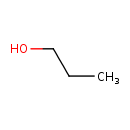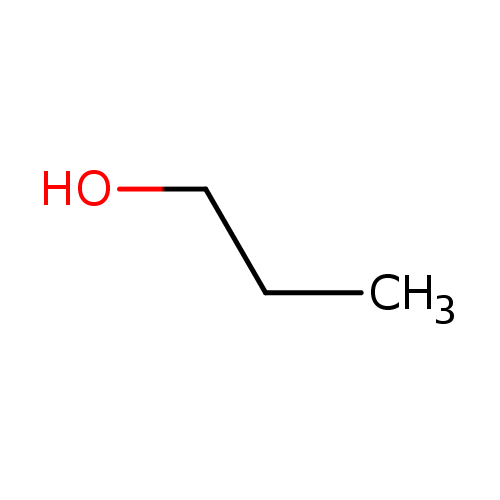|
Record Information |
|---|
| Version |
1.0 |
|---|
| Update Date |
1/22/2018 11:54:54 AM |
|---|
|
Metabolite ID | PAMDB120157 |
|---|
|
Identification |
|---|
| Name: |
n-propanol |
|---|
| Description: | The parent member of the class of propan-1-ols that is propane in which a hydrogen of one of the methyl groups is replaced by a hydroxy group. |
|---|
|
Structure |
|
|---|
| Synonyms: | - 1-Hydroxypropane
- 1-Propanol
- 1-propanol
- ethyl carbinol
- Ethylcarbinol
- n-propan-1-ol
- n-Propanol
- N-PROPANOL
- n-Propyl alcohol
- n-Propylalkohol
- Optal
- Osmosol extra
- Propan-1-ol
- Propane-1-ol
- Propanol
- propanol-1
- Propyl alcohol
- UN 1274
|
|---|
|
Chemical Formula: |
C3H8O |
|---|
| Average Molecular Weight: |
60.096 |
|---|
| Monoisotopic Molecular
Weight: |
60.057514 |
|---|
| InChI Key: |
BDERNNFJNOPAEC-UHFFFAOYSA-N |
|---|
| InChI: | InChI=1S/C3H8O/c1-2-3-4/h4H,2-3H2,1H3 |
|---|
| CAS
number: |
71-23-8 |
|---|
| IUPAC Name: | propan-1-ol |
|---|
|
Traditional IUPAC Name: |
propanol |
|---|
| SMILES: | CCCO |
|---|
|
Chemical Taxonomy |
|---|
|
Taxonomy Description | This compound belongs to the class of organic compounds known as primary alcohols. These are compounds comprising the primary alcohol functional group, with the general structure RCOH (R=alkyl, aryl). |
|---|
|
Kingdom |
Organic compounds |
|---|
| Super Class | Organic oxygen compounds |
|---|
|
Class |
Organooxygen compounds |
|---|
| Sub Class | Alcohols and polyols |
|---|
|
Direct Parent |
Primary alcohols |
|---|
| Alternative Parents |
|
|---|
| Substituents |
- Hydrocarbon derivative
- Primary alcohol
- Aliphatic acyclic compound
|
|---|
| Molecular Framework |
Aliphatic acyclic compounds |
|---|
| External Descriptors |
|
|---|
|
Physical Properties |
|---|
| State: |
Liquid |
|---|
| Charge: | 0 |
|---|
|
Melting point: |
-126.1 °C |
|---|
| Experimental Properties: |
| Property | Value | Reference |
|---|
| Melting Point | -126.1 °C | Not Available | | Boiling Point | Not Available | Not Available | | Water Solubility | 1000.0 mg/mL | Not Available | | LogP | 0.25 | HANSCH,C ET AL. (1995) |
|
|---|
| Predicted Properties |
|
|---|
|
Biological Properties |
|---|
| Cellular Locations: |
Not Available |
|---|
| Reactions: | |
|---|
|
Pathways: |
|
|---|
|
Spectra |
|---|
| Spectra: |
| Spectrum Type | Description | Splash Key | |
|---|
| Predicted GC-MS | Predicted GC-MS Spectrum - GC-MS | Not Available |
|---|
| LC-MS/MS | LC-MS/MS Spectrum - Quattro_QQQ 10V, Positive (Annotated) | splash10-03di-9000000000-8e60a750ac016bf5f9f7 | View in MoNA |
|---|
| LC-MS/MS | LC-MS/MS Spectrum - Quattro_QQQ 25V, Positive (Annotated) | splash10-03dl-9000000000-17658e49fed270452ed4 | View in MoNA |
|---|
| LC-MS/MS | LC-MS/MS Spectrum - Quattro_QQQ 40V, Positive (Annotated) | splash10-03dl-9000000000-10c2ef6f2c375973e1a9 | View in MoNA |
|---|
| LC-MS/MS | LC-MS/MS Spectrum - EI-B (HITACHI RMU-6M) , Positive | splash10-001i-9000000000-b16d56b3c4fc95e00c56 | View in MoNA |
|---|
| LC-MS/MS | LC-MS/MS Spectrum - EI-B (HITACHI M-80B) , Positive | splash10-001i-9000000000-16b5a3548bcbe12e38bb | View in MoNA |
|---|
| LC-MS/MS | LC-MS/MS Spectrum - EI-B (HITACHI RMU-7M) , Positive | splash10-001i-9000000000-6013791cdd19a27be85c | View in MoNA |
|---|
| Predicted LC-MS/MS | Predicted LC-MS/MS Spectrum - 10V, Positive | splash10-01ox-9000000000-06ef5e8e7805851d0737 | View in MoNA |
|---|
| Predicted LC-MS/MS | Predicted LC-MS/MS Spectrum - 20V, Positive | splash10-0006-9000000000-03159cae015c86b655e0 | View in MoNA |
|---|
| Predicted LC-MS/MS | Predicted LC-MS/MS Spectrum - 40V, Positive | splash10-0006-9000000000-db45d3e7d2ae1653f76e | View in MoNA |
|---|
| Predicted LC-MS/MS | Predicted LC-MS/MS Spectrum - 10V, Negative | splash10-0a4i-9000000000-9517aa42fced76eff1d2 | View in MoNA |
|---|
| Predicted LC-MS/MS | Predicted LC-MS/MS Spectrum - 20V, Negative | splash10-0a4i-9000000000-f78c10cac4b60ad41988 | View in MoNA |
|---|
| Predicted LC-MS/MS | Predicted LC-MS/MS Spectrum - 40V, Negative | splash10-0006-9000000000-fb6c8a2550ff427023d8 | View in MoNA |
|---|
| MS | Mass Spectrum (Electron Ionization) | splash10-001i-9000000000-cdf3b05a292d7d658a6f | View in MoNA |
|---|
| 1D NMR | 1H NMR Spectrum | Not Available |
|---|
| 1D NMR | 1H NMR Spectrum | Not Available |
|---|
| 1D NMR | 13C NMR Spectrum | Not Available |
|---|
| 1D NMR | 1H NMR Spectrum | Not Available |
|---|
| 1D NMR | 13C NMR Spectrum | Not Available |
|---|
| 2D NMR | [1H,13C] 2D NMR Spectrum | Not Available |
|---|
|
|---|
|
References |
|---|
| References: |
- Below H, Partecke I, Huebner NO, Bieber N, Nicolai T, Usche A, Assadian O, Below E, Kampf G, Parzefall W, Heidecke CD, Zuba D, Bessonneau V, Kohlmann T, Kramer A (2012)Dermal and pulmonary absorption of propan-1-ol and propan-2-ol from hand rubs. American journal of infection control 40, Pubmed: 21741120
- Raducan A, Cantemir AR, Puiu M, Oancea D (2012)Kinetics of hydrogen peroxide decomposition by catalase: hydroxylic solvent effects. Bioprocess and biosystems engineering 35, Pubmed: 22565543
|
|---|
| Synthesis Reference: |
Ito, Kenji; Katao, Masaaki. Process for manufacturing propylene oxide and propyl alcohol. Jpn. Kokai Tokkyo Koho (2003), 4 pp. |
|---|
| Material Safety Data Sheet (MSDS) |
Download (PDF) |
|---|
|
Links |
|---|
| External Links: |
|
|---|


